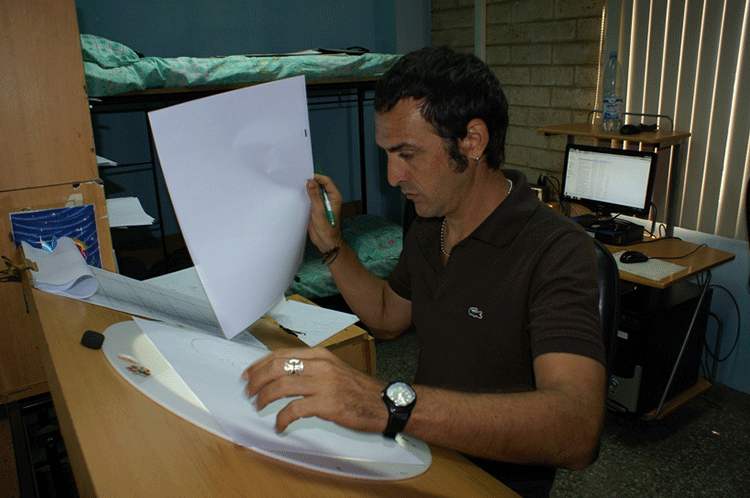Alexander Rodríguez is a young cartoons producer who was born in the 70’s. He declared an heir of anime Japanese from the screening of “VOLTUS-V” in Cuba. However, as a professional he doesn’t dismiss the legacy of Disney and Cuban animation for young producers. He is particularly interested in taking renowned literary and cinema productions to Cuban animation. Some of his works include the story of Nene Traviesa, by Jose Marti, and Quietud interrumpida, inspired in El Herido, the first story in the film Historias de la Revolución, by Tomás (Titón) Gutiérrez Alea. Nowadays, he is working on a new project based on the homonymous piece Las Aventuras de Juan QuinQuin en pueblo Mocho, by Samuel Feijoo. This project pays homage to that Cuban intellectual, who devoted his life and work to rescue our rural culture. OnCuba met with Alexander Rodríguez to talk about this new animation project.
Why “Las aventuras de Juan QuinQuin”?
Juan QuinQuin is very Cuban, that’s the first motivation found in the characters of our literature. To me, Juan QuinQuin reflects the classic Cuban and that led me to include music from the 20’s, the beginnings of son, which is the roots of salsa, and to recreate that epoch. Besides, this year we are celebrating Samuel Feijoo’s centennial and it is an honor for me to commemorate this date and this figure by taking this renowned piece by the Cuban audience to a cartoon.
What did you use as reference for developing your project: the film or the TV series?
We all know this piece has been taken to the television and the cinema, both versions stared by Cuban actor Julito Martinez. For that reason, I used his image to make a caricature. I’m interested in maintaining the image of Julito Martinez, but this time as a cartoon. I would like to point out that Juan QuinQuin was a real character; he was a black man who used to work as stevedore in Matanzas province, he was friend with Feijoo. His friend had nothing to do with the design of the character created for the cinema and the television. Therefore, we decided to create our own Juan QuinQuin, a mulatto who resembled Julito Martinez. It is worth highlighting Amelia Feijoo’s contribution to the project. I want to have my own Juan QuinQuin as Julio García Espinosa and Eduardo Macías did in the cinema and the television respectively.
Researchers affirm that the so-called “popular religiousness” has been traditionally present among Cuban farmers. Can you tell us why you have privileged afro-Cuban religions in your proposal?
The Cuban countryside is diverse. Feijoo spent many years travelling across the countryside collecting stories from farmers. I have mixed religious beliefs and mythsfrom different origins in local customs. The Yoruba religion is present in Feijoo’s work and I privileged it because in terms of portraying it in a film, it is more interesting than other religions. It is more picturesque and it makes fantasizing easier. However, it doesn’t mean it is more serious, and for that we are taking Natalia Bolivar as support. In my opinion, it has more to offer, cinematographically speaking, that other religious beliefs. That’s what we tried to use in Juan QuinQuin.
How would you characterize this project?
We are working over the traditional technique, paper drawing, by plains and cleanliness. The finish is digital. It is pretty easy to do and it allows the film to be more realistic. As to photography, for instance, we are trying to portray deep fields, with a realistic lighting, though the characters are cartoons. This helps us display the greatness of the Cuban landscapes. Color also contributes with that depth for the number of green, ocher shades and the blue of our sky which contrasts with all that green, and with enjoying the range of colors of our fields. When you see it, you will think it’s a fiction movie.
What’s the structure you have planned for the film? What can you say about the cast? Who are they?
It is a 21-minute long film for the family. Its language is very Cuban, but universal. It is in the category of adventure. As to the cast I have no complains. It is made up of top actors: Juan QuinQuin is interpreted by young actor Lieter Ledesma, with a fresh voice and an hyperactive personality, characteristics that suit the character; Luisa María Jiménez plays OBBA; Broselianda Hernández OYÁ and Aurora Basnuevo YEWÁ,the three goddess looking after the cemetery; actress Obelia Blanco interprets Yemayá; Mariela Bejerano is Juan’s mother; Néstor Jiménez is Pancho; Patricio Wood, is Matasiete and Aramis Delgado plays Ruperto. I have to highlight Kevin Sánchez’s debut, a boy who gives voice to Juan as a little boy. As for music, I invited Vicente Alejandro Trigo, director of the band CoraSon and Israel Rojas, songwriter and composer from Buena Féto write the song for the film. We hope to premiere the film this summer and we hope children and adults enjoy it.
By Mirtha Lamothe Iglesias










